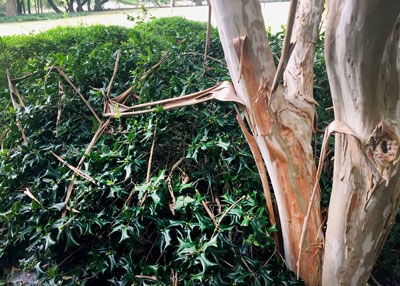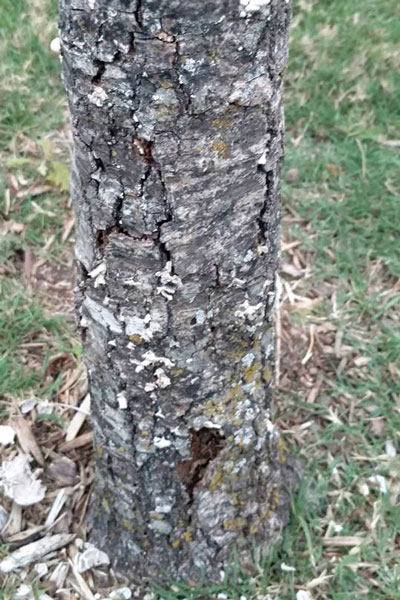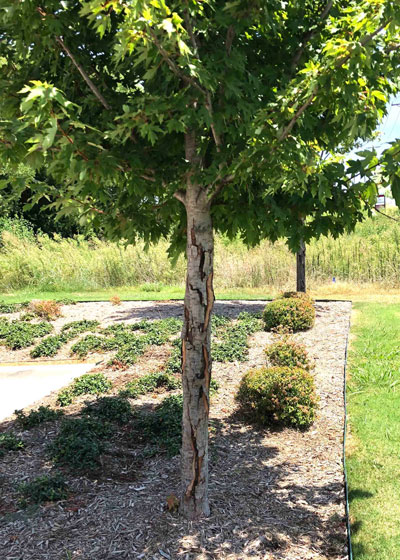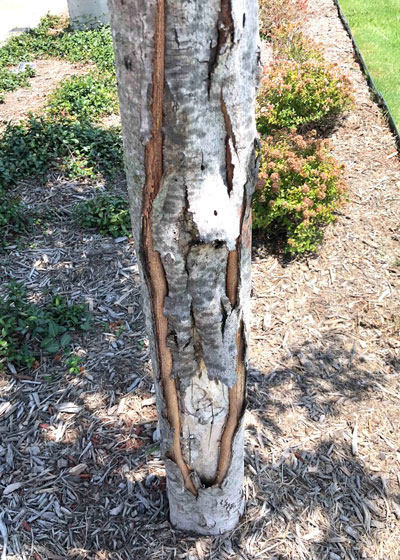Question of the Week – Number 2: August 22, 2019
“Why is the bark on my tree splitting?”
Before I get into an answer we need to discuss two basic facts. First, bark is a dead tissue. As such, it cannot expand. Hang onto that information. We’ll come back to it later.
And, remember that bark serves to protect trees’ trunks from outside injuries. Most of those are obvious, like mower wheels and line trimmers. Bark does what it can to protect trees from being gouged. But there’s more to that story, too.

For some trees, sloughing bark is absolutely normal…
Bark cells are dead. Remember that? Sloughing of bark is a routine process for almost all trees. Bark cells grow to full size, then they die. As the tree’s trunk grows thicker (like a waistline), all it can do is pop off.
For some trees, like cedar elms and magnolias, that sloughing involves small chunks of bark that are hardly noticeable. However, for others like paperbark maple, river birch, sycamore, crape myrtles, and sometimes even pecans, those sheets are quite long and very conspicuous. But that sloughing is absolutely not threatening.
And then there are times when splitting, peeling bark is a big concern…
It’s when oaks, maples and Chinese pistachios, among other trees, start losing big pieces of bark that you begin to worry about sunscald, decay and borers.
These are all trees that have very thin bark when they’re young. While they’re growing next to one another in the nursery they offer protection of mutual shading so nothing much happens.



When we set these trees out into our landscapes exposed to the hot Texas sun they soon run into problems. The west and south sun in the summer beats on their exposed trunks, overheats the wood and ultimately causes it to crack and peel away after three or four years.
Without that bark the conducting tissues that carry sugars from the leaves down to the roots are severed and the tree ends up dying.
This is why I say that wrapping trunks of new oaks, maples and Chinese pistachios is critical for their first couple of years. Paper tree wrap is sold by nurseries and hardware stores. Several types are available, and for just a few dollars per tree they can make a life-saving difference.
Hypoxylon canker causes post oaks to lose bark…
Following the extreme drought of 2011 many of our tree species were severely damaged. Post oaks were especially hard hit, and within a couple of years (and even up to today), large pieces of bark were falling off.
There is an opportunistic organism known as Hypoxylon canker. In its own right it rarely attacks healthy trees. But when a tree is weakened it can move in. Having seen many cases of it, the folks at Arborilogical Services in DFW keep this on their website.
Note: In the spirit of openness, Arborilogical Services advertises in e-gardens and on my radio programs and website. They do all of the maintenance work on the trees in the Sperry landscape as well.
